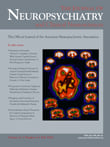Obsessive-Compulsive Disorder Following Cavernous Sinus Thrombosis
To the Editor: Injury to the brain is known to result in psychiatric disorders. Several authors have reported obsessive-compulsive disorder (OCD) following different types of brain injury, including head trauma, cerebrovascular accidents, brain infections, and brain tumors. 1 Studies of OCD following cerebrovascular accidents are few and mostly constitute case reports of strokes.
We present a case of a 51-year-old man who developed OCD after cavernous sinus thrombosis and was successfully treated with paroxetine.
Case Report
The patient was admitted to a neurological clinic because of a severe headache and brought to an intensive care unit 12 hours later because he became lethargic. Brain MRI and magnetic resonance angiogram (MRA) ( Figure 1 ) showed right cavernous sinus thrombosis and possible meningoencephalitis. He received broad-spectrum antibiotic therapy and low mol weight heparin for 6 weeks. Surgical sinus drainage was not performed. The patient was discharged 2 months after the admission with only ophthalmoplegia. A second MRI showed no evidence of meningoencephalitis or structural brain damage.

MRI (left) demonstrates right cavernous sinus thrombosis and meningeal enrichment of the temporal lobe area; MRA (Right) demonstrates no filling of the right cavernous sinus indicating cavernous sinus thrombosis.
During his hospitalization the patient progressively developed obsessive symptoms, which prompted him to seek psychiatric help a few days after the hospital discharge. He had repeated thoughts that “something terrible,” such as a thunderbolt, would cause him somatic damage and had thoughts to kill his wife with a knife. He recognized that his obsessions were unreasonable; however, they caused him excessive distress. No compulsive symptoms were present in any time of the disorder. There was no history of psychiatric illness or substance abuse in the patient or his family.
The patient received an axis I diagnosis of OCD according to DSM-IV criteria (Yale-Brown Obsessive Compulsive Scale score=17) and was treated with up to 60 mg/day of paroxetine. Two months later his symptoms remitted gradually (Y-BOCS=9), and 6 months later he did not manifest any obsessions (Y-BOCS=3). In follow-ups 1 and 2 years after pharmacotherapy discontinuation, he remained asymptomatic.
Discussion
Obsessive-compulsive disorder can follow several different types of acquired brain injury, including stroke, head trauma, tumors, and brain infections. Only a few case studies of OCD following cerebrovascular accidents have been described. In most of them, focal brain lesions, including the frontal cortex and basal ganglia, resulting from strokes were identified. 1 , 2 In our case MRI revealed no macroscopic evidence of permanent structural brain damage. However, a more detailed analysis of the MRI images, which could detect subtle structure alterations, has not been performed. Discrete subcortical lesions that disrupt circuits may disconnect distant areas or lead to remote changes in brain metabolism, which could potentially affect neuroanatomical circuits implicated in OCD. Furthermore, while the functional circuitry implicated in the pathophysiology of idiopathic OCD is generally believed to involve a cortico-striatal-thalamic-cortical circuit, 3 the neuroanatomical basis for OCD following brain injury remains unclear.
Finally, specific treatment for acquired OCD has scarcely been studied. Data suggest that the same medications, selective serotonin reuptake inhibitors (SSRIs), which have been found to be effective in treating idiopathic OCD, are also effective in treating acquired OCD. 4 , 5 Therefore SSRIs are indicated for the treatment of both disorders.
1. Coetzer BR: Obsessive-compulsive disorder following brain injury: a review. Int J Psychiatry Med 2004; 34:363–377Google Scholar
2. Berthier ML, Kulisevsky JJ, Gironell A, et al: Obsessive-compulsive disorder and traumatic brain injury: behavioral, cognitive, and neuroimaging findings. Neuropsychiatry Neuropsychol Behav Neurol 2001; 14:23–31Google Scholar
3. Stein DJ: Obsessive-compulsive disorder. Lancet 2002; 360:397–405Google Scholar
4. Bhangoo RK: Pathophysiology and treatment of secondary obsessive-compulsive behaviors and tics. Semin Clin Neuropsychiatry 2000; 5:250–258Google Scholar
5. Stengler-Wenzke K, Muller U: Fluoxetine for OCD after brain injury. Am J Psychiatry 2002; 159:872Google Scholar



